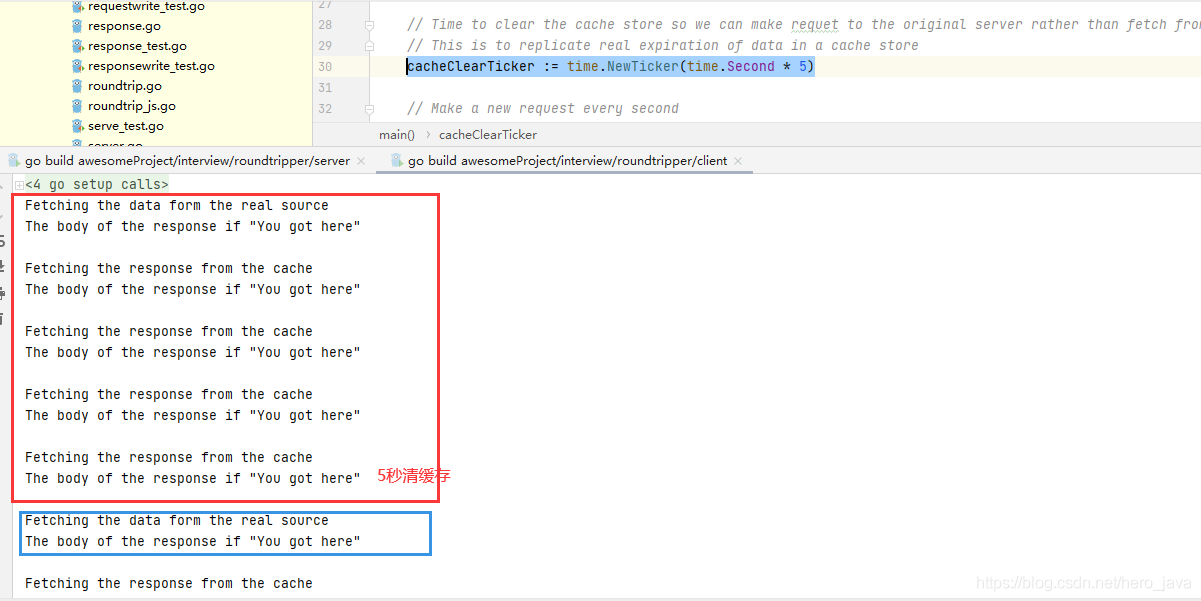深度剖析:Go语言中的http.RoundTripper
发表时间: 2022-12-12 23:51

1、RoundTripper 接口
// RoundTripper is an interface representing the ability to execute a// single HTTP transaction, obtaining the Response for a given Request.//// A RoundTripper must be safe for concurrent use by multiple// goroutines.type RoundTripper interface { // RoundTrip executes a single HTTP transaction, returning // a Response for the provided Request. // // RoundTrip should not attempt to interpret the response. In // particular, RoundTrip must return err == nil if it obtained // a response, regardless of the response's HTTP status code. // A non-nil err should be reserved for failure to obtain a // response. Similarly, RoundTrip should not attempt to // handle higher-level protocol details such as redirects, // authentication, or cookies. // // RoundTrip should not modify the request, except for // consuming and closing the Request's Body. RoundTrip may // read fields of the request in a separate goroutine. Callers // should not mutate or reuse the request until the Response's // Body has been closed. // // RoundTrip must always close the body, including on errors, // but depending on the implementation may do so in a separate // goroutine even after RoundTrip returns. This means that // callers wanting to reuse the body for subsequent requests // must arrange to wait for the Close call before doing so. // // The Request's URL and Header fields must be initialized. RoundTrip(*Request) (*Response, error)}一句话概括:可以把RoundTripper看成是 http.Client 的中间件
2、场景
(1)缓存http responses。如果缓存中存在,则直接从缓存中取。如果缓存中不存在,则重新请求
(2)根据需要适当的设置HTTP headers
(3)Rate limiting
3、实例
使用HTTP.roundtripper的实现来缓存HTTP响应
(1)实现一个 HTTP Server
package mainimport ( "fmt" "net/http")func main() { mux := http.NewServeMux() mux.HandleFunc("/", func(writer http.ResponseWriter, request *http.Request) { //This is here so wen can actually see what the responses that have been cached don't get here fmt.Println("The request actually got here") writer.Write([]byte("You got here")) }) http.ListenAndServe(":8080", mux)}(2)新建一个http.Transport并且实现 http.RoundTripper接口,同时让其具有缓存功能
package cacheTransportimport ( "bufio" "bytes" "errors" "fmt" "net" "net/http" "net/http/httputil" "sync" "time")func cachKey(r *http.Request) string { return r.URL.String()}type CacheTransport struct { data map[string]string mu sync.RWMutex originalTransport http.RoundTripper}func NewCacheTransport() *CacheTransport { return &CacheTransport{ data: make(map[string]string, 20), originalTransport: &http.Transport{ DialContext: (&net.Dialer{ Timeout: 2 * time.Second, KeepAlive: 30 * time.Second, DualStack: true, }).DialContext, ResponseHeaderTimeout: 5 * time.Second, MaxIdleConns: 100, IdleConnTimeout: 90 * time.Second, TLSHandshakeTimeout: 10 * time.Second, }}}func (c *CacheTransport) RoundTrip(r *http.Request) (*http.Response, error) { //Check if we have the respose cached... // if yes,we don't have to hit the server // we just return it as is from the cache store. if val, err := c.Get(r); err == nil { fmt.Println("Fetching the response from the cache") return cachedResponse([]byte(val), r) } // we don't have the response cached,the store was probably cleared. // Make the request to the server resp, err := c.originalTransport.RoundTrip(r) if err != nil { return nil, err } // Get the body of the response so we can save it int the cache for the next request. buf, err := httputil.DumpResponse(resp, true) if err != nil { return nil, err } //Saving it to the store c.Set(r, string(buf)) fmt.Println("Fetching the data form the real source") return resp, nil}func cachedResponse(b []byte, r *http.Request) (*http.Response, error) { buf := bytes.NewBuffer(b) return http.ReadResponse(bufio.NewReader(buf), r)}func (c *CacheTransport) Set(r *http.Request, value string) { c.mu.Lock() defer c.mu.Unlock() c.data[cachKey(r)] = value}func (c *CacheTransport) Get(r *http.Request) (string, error) { c.mu.Lock() defer c.mu.Unlock() if val, ok := c.data[cachKey(r)]; ok { return val, nil } return "", errors.New("key not found in cache")}func (c *CacheTransport) Clear() error { c.mu.Lock() c.mu.Unlock() c.data = make(map[string]string) return nil}(3)实现客户端的引导程序main函数,同时具有一个timer来定时清理缓存
package mainimport ( "awesomeProject/interview/roundtripper/cacheTransport" "fmt" "io/ioutil" "log" "net/http" "os" "os/signal" "strings" "syscall" "time")func main() { cacheTransport := cacheTransport.NewCacheTransport() // Create a custom client so we can make use of our RoundTripper // If you make use of http.Get(),the default http client located at http.DefaultClient is used instead // Since we have special needs,we have to make use of our own http.RoundTripper implementation client := &http.Client{ Transport: cacheTransport, Timeout: time.Second * 5, } // Time to clear the cache store so we can make requet to the original server rather than fetch from the cache store // This is to replicate real expiration of data in a cache store cacheClearTicker := time.NewTicker(time.Second * 5) // Make a new request every second // This would help demonstrate if the response if coming from the real server or the cache reqTicker := time.NewTicker(time.Second * 1) terminateChannel := make(chan os.Signal, 1) signal.Notify(terminateChannel, syscall.SIGTERM, syscall.SIGHUP) req, err := http.NewRequest(http.MethodGet, "http://localhost:8080", strings.NewReader("")) if err != nil { panic("Whoops") } for { select { case <-cacheClearTicker.C: // Clear the cache so we can hit the original server cacheTransport.Clear() case <-terminateChannel: cacheClearTicker.Stop() reqTicker.Stop() return case <-reqTicker.C: resp, err := client.Do(req) if err != nil { log.Printf("An error occurred.... %v", err) continue } buf, err := ioutil.ReadAll(resp.Body) if err != nil { log.Printf("An error occurred...%v", err) continue } fmt.Printf("The body of the response if \"%s\" \n\n", string(buf)) } }}(4)服务端执行结果如下

客户端执行结果如下:
